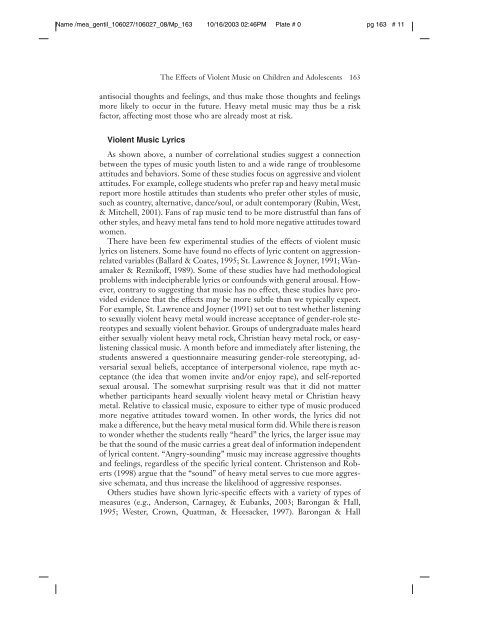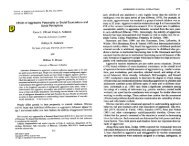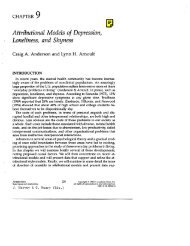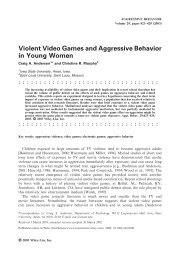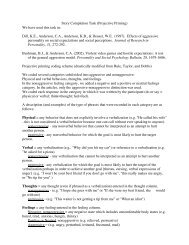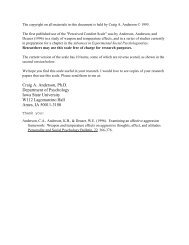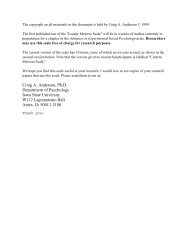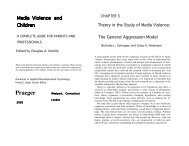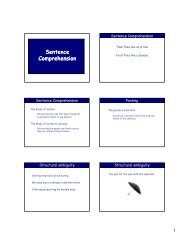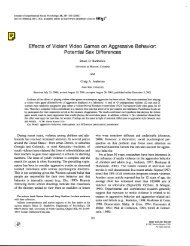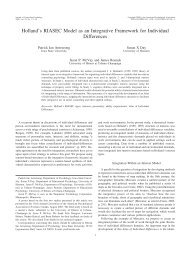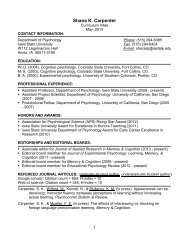The Effects of Violent Music on Children and Adolescents
The Effects of Violent Music on Children and Adolescents
The Effects of Violent Music on Children and Adolescents
Create successful ePaper yourself
Turn your PDF publications into a flip-book with our unique Google optimized e-Paper software.
Name /mea_gentil_106027/106027_08/Mp_163 10/16/2003 02:46PM Plate # 0 pg 163 # 11<br />
<str<strong>on</strong>g>The</str<strong>on</strong>g> <str<strong>on</strong>g>Effects</str<strong>on</strong>g> <str<strong>on</strong>g>of</str<strong>on</strong>g> <str<strong>on</strong>g>Violent</str<strong>on</strong>g> <str<strong>on</strong>g>Music</str<strong>on</strong>g> <strong>on</strong> <strong>Children</strong> <strong>and</strong> <strong>Adolescents</strong> 163<br />
antisocial thoughts <strong>and</strong> feelings, <strong>and</strong> thus make those thoughts <strong>and</strong> feelings<br />
more likely to occur in the future. Heavy metal music may thus be a risk<br />
factor, affecting most those who are already most at risk.<br />
<str<strong>on</strong>g>Violent</str<strong>on</strong>g> <str<strong>on</strong>g>Music</str<strong>on</strong>g> Lyrics<br />
As shown above, a number <str<strong>on</strong>g>of</str<strong>on</strong>g> correlati<strong>on</strong>al studies suggest a c<strong>on</strong>necti<strong>on</strong><br />
between the types <str<strong>on</strong>g>of</str<strong>on</strong>g> music youth listen to <strong>and</strong> a wide range <str<strong>on</strong>g>of</str<strong>on</strong>g> troublesome<br />
attitudes <strong>and</strong> behaviors. Some <str<strong>on</strong>g>of</str<strong>on</strong>g> these studies focus <strong>on</strong> aggressive <strong>and</strong> violent<br />
attitudes. For example, college students who prefer rap <strong>and</strong> heavy metal music<br />
report more hostile attitudes than students who prefer other styles <str<strong>on</strong>g>of</str<strong>on</strong>g> music,<br />
such as country, alternative, dance/soul, or adult c<strong>on</strong>temporary (Rubin, West,<br />
& Mitchell, 2001). Fans <str<strong>on</strong>g>of</str<strong>on</strong>g> rap music tend to be more distrustful than fans <str<strong>on</strong>g>of</str<strong>on</strong>g><br />
other styles, <strong>and</strong> heavy metal fans tend to hold more negative attitudes toward<br />
women.<br />
<str<strong>on</strong>g>The</str<strong>on</strong>g>re have been few experimental studies <str<strong>on</strong>g>of</str<strong>on</strong>g> the effects <str<strong>on</strong>g>of</str<strong>on</strong>g> violent music<br />
lyrics <strong>on</strong> listeners. Some have found no effects <str<strong>on</strong>g>of</str<strong>on</strong>g> lyric c<strong>on</strong>tent <strong>on</strong> aggressi<strong>on</strong>related<br />
variables (Ballard & Coates, 1995; St. Lawrence & Joyner, 1991; Wanamaker<br />
& Reznik<str<strong>on</strong>g>of</str<strong>on</strong>g>f, 1989). Some <str<strong>on</strong>g>of</str<strong>on</strong>g> these studies have had methodological<br />
problems with indecipherable lyrics or c<strong>on</strong>founds with general arousal. However,<br />
c<strong>on</strong>trary to suggesting that music has no effect, these studies have provided<br />
evidence that the effects may be more subtle than we typically expect.<br />
For example, St. Lawrence <strong>and</strong> Joyner (1991) set out to test whether listening<br />
to sexually violent heavy metal would increase acceptance <str<strong>on</strong>g>of</str<strong>on</strong>g> gender-role stereotypes<br />
<strong>and</strong> sexually violent behavior. Groups <str<strong>on</strong>g>of</str<strong>on</strong>g> undergraduate males heard<br />
either sexually violent heavy metal rock, Christian heavy metal rock, or easylistening<br />
classical music. A m<strong>on</strong>th before <strong>and</strong> immediately after listening, the<br />
students answered a questi<strong>on</strong>naire measuring gender-role stereotyping, adversarial<br />
sexual beliefs, acceptance <str<strong>on</strong>g>of</str<strong>on</strong>g> interpers<strong>on</strong>al violence, rape myth acceptance<br />
(the idea that women invite <strong>and</strong>/or enjoy rape), <strong>and</strong> self-reported<br />
sexual arousal. <str<strong>on</strong>g>The</str<strong>on</strong>g> somewhat surprising result was that it did not matter<br />
whether participants heard sexually violent heavy metal or Christian heavy<br />
metal. Relative to classical music, exposure to either type <str<strong>on</strong>g>of</str<strong>on</strong>g> music produced<br />
more negative attitudes toward women. In other words, the lyrics did not<br />
make a difference, but the heavy metal musical form did. While there is reas<strong>on</strong><br />
to w<strong>on</strong>der whether the students really “heard” the lyrics, the larger issue may<br />
be that the sound <str<strong>on</strong>g>of</str<strong>on</strong>g> the music carries a great deal <str<strong>on</strong>g>of</str<strong>on</strong>g> informati<strong>on</strong> independent<br />
<str<strong>on</strong>g>of</str<strong>on</strong>g> lyrical c<strong>on</strong>tent. “Angry-sounding” music may increase aggressive thoughts<br />
<strong>and</strong> feelings, regardless <str<strong>on</strong>g>of</str<strong>on</strong>g> the specific lyrical c<strong>on</strong>tent. Christens<strong>on</strong> <strong>and</strong> Roberts<br />
(1998) argue that the “sound” <str<strong>on</strong>g>of</str<strong>on</strong>g> heavy metal serves to cue more aggressive<br />
schemata, <strong>and</strong> thus increase the likelihood <str<strong>on</strong>g>of</str<strong>on</strong>g> aggressive resp<strong>on</strong>ses.<br />
Others studies have shown lyric-specific effects with a variety <str<strong>on</strong>g>of</str<strong>on</strong>g> types <str<strong>on</strong>g>of</str<strong>on</strong>g><br />
measures (e.g., Anders<strong>on</strong>, Carnagey, & Eubanks, 2003; Bar<strong>on</strong>gan & Hall,<br />
1995; Wester, Crown, Quatman, & Heesacker, 1997). Bar<strong>on</strong>gan & Hall


